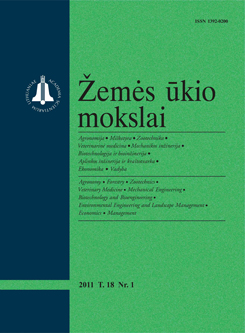Žemės ūkio mokslai / Agricultural Sciences
WHAT?
 ISSN 1392-0200 |
2007 m. Nr. 1 Genetic factors influencing milk production traits
in Lithuanian dairy cattle breeds
394 unrelated Lithuanian dairy cows (Lithuanian Black & White 109, Lithuanian Red 168, Lithuanian Light Grey 68 and Lithuanian White Backed 49) were evaluated to test the influence of milk protein genotypes milk to production and milk composition traits. Milk protein genes were identified by polymerase chain reaction (PCR) and the RFLP method. The results showed a positive effect of the BB genotype of kappa-casein on milk fat and protein content, however, this genotype had a negative effect on milk yield. The Alphas1-casein BB genotype showed milk yield, whereas the alphas1-casein CC genotype produced more protein. The whey protein BB genotype of the beta-lactoglobulin locus influenced milk fat level, whereas the beta-lactoglobulin BC genotype was produced more protein. Differences among the milk protein genotypes were estimated. Cows with kappa-casein locus AA genotype produced more milk (175.7 kg; p < 0.05) and a higher (2.88 kg; P < 0.001) protein average than did AB genotype carrier cows. However, milk of cows with AB genotype was superior according to fat (0.23%; p < 0.001) and protein (0.06%; p < 0.001) content. Milk of cows with the kappa-casein locus BB genotype, beneficial for milk processing, was superior according to fat (0.27%; p < 0.05) and protein (0.21%; p < 0.001) average levels versus the kappa-casein locus AA genotype.
Comparing the differences between the BB and CC genotypes of alphas1-casein it was estimated that cows of the BB genotype produced more milk (1344 kg; p < 0.05), however, in cows of the CC genotype milk had a higher (by 0.35%) protein. Cows carrying the AB genotype of beta-lactoglobulin produced more milk (by 332.2 kg; p < 0.01) and milk had more (by 0.10%, p < 0.05) fat compared with cows that carried AA genotype. The BB genotype influenced milk protein level (by 0.20%, p < 0.001) more than did the AA genotype. According to the research results, in respect of beta-lactoglobulin and kappa-casein genotypes of milk protein, it could be possible to certify pedigree cattle – to select cows, bulls and their semen genetically, testing genes determining the qualitative composition of milk protein. The results may be used to improve genetically their breeding value and the quality of milk. Raktažodžiai: casein, lactoglobulin, milk, cattle |
Numeriai:
2012 - T.19 Nr.1 2011 - T.18 Nr.1, Nr.2, Nr.3, Nr.4 2010 - T.17 Nr.1-2, Nr.3-4 2009 - T.16 Nr.1-2, Nr.3-4 2008 - T.15 Nr.1, Nr.2, Nr.3, Nr.4 2007 - T.14 Nr.1, Nr.2, Nr.3, Nr.4, Nr.Priedas 2006 Nr.1, Nr.1.Priedas, Nr.2, Nr.3, Nr.4 2005 Nr.1, Nr.2, Nr.3, Nr.4 2004 Nr.1, Nr.2, Nr.3, Nr.4 2003 Nr.1, Nr.2, Nr.3, Nr.4 2002 Nr.1, Nr.2, Nr.3, Nr.4 2001 Nr.1, Nr.2, Nr.3, Nr.4 |